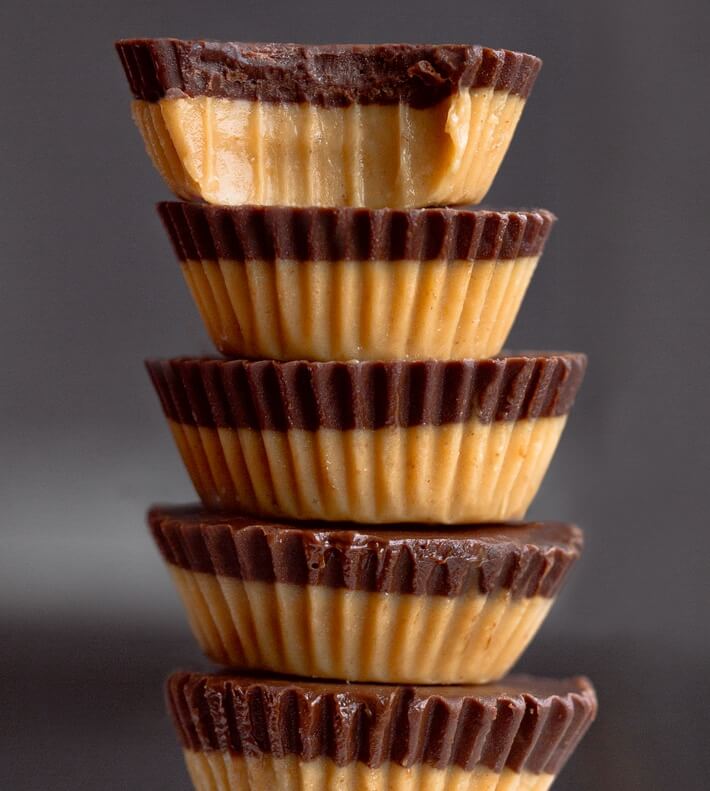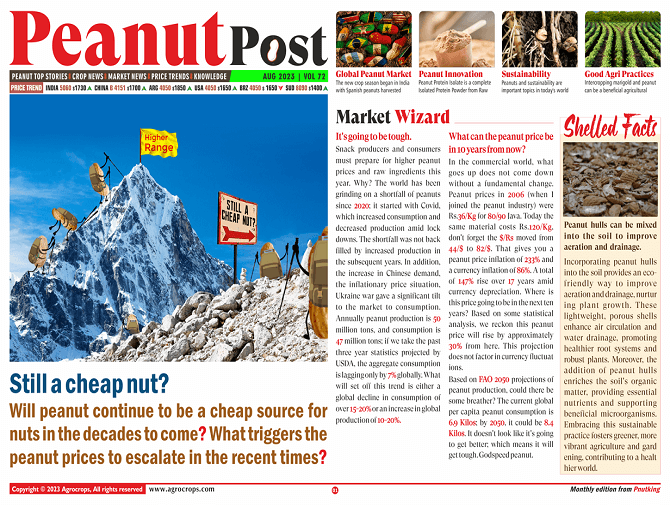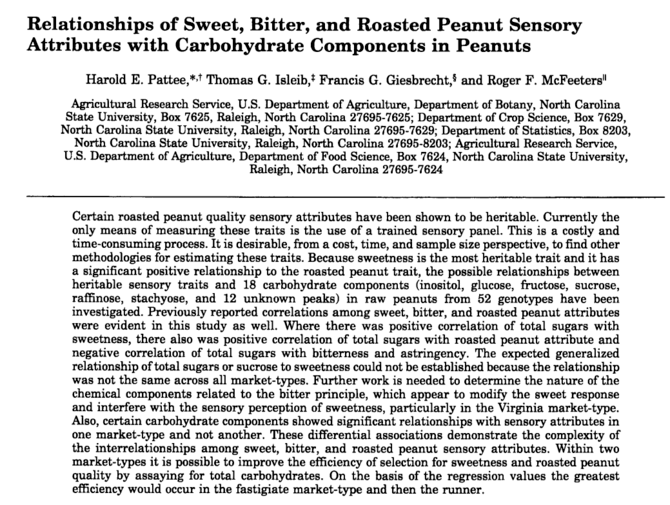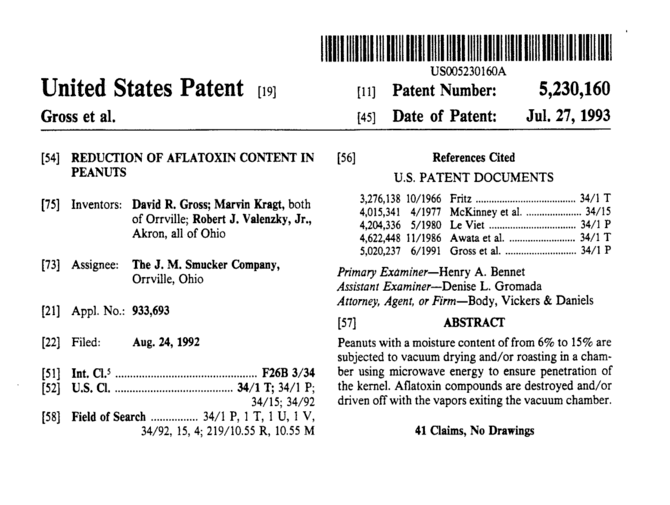

An ounce of information
.jpg)
Article by Pnut King
Published on 08/23/2023 in Peanut News
The modern peanut is a versatile nut. With unique calorific and nutritional properties, it features in a wide range of products, and is used in many original – and surprising – applications. Each invention has led peanut innovators down a lucrative and exciting path, and even those which ultimately proved unsuccessful helped us to learn more about this incredible nut.
From time bombs to diesel engines, peanuts have influenced our lives in many ways, and they continue to prove useful to those willing to explore their value.
Here, we’ll take a look at some of the greatest peanut innovations: those that rose to the top and became hugely popular, and even some which didn’t quite make the mark.
To begin, let’s take a look at some of the most popular uses of peanuts. Both as an ingredient and a resource for useful products. With the explosion in peanut popularity worldwide, and with consumption showing no sign of slowing, it’s no surprise that popular and not so popular products have also flourished in the market, as producers and manufacturers try to seize the attention of global consumers.
Here are some of the best and most noteworthy peanut products available today, and in development.
No exploration of peanut inventions would be truly complete without giving due attention to peanut butter. One of the biggest early peanut innovations, it remains one of the most influential today.
An early form of peanut butter was invented by the Incan people, who are known to have ground peanuts into a paste and even combined it with honey for flavour. However, the North Americans took the idea to another level. In 1884 Canadian chemist Marcellus Gilmore Edson was issued a patent by the United States Patent Office for the manufacturing of “peanut-candy”, a kind of peanut paste made from ground roasted peanuts. It had “a consistency like that of butter, lard, or ointment,” and could be combined with sugar and used as a “flavoring-paste…to form sweetmeats and candy.” Then, in 1895, John Harvey Kellogg filed a now famous patent for peanut butter, and he used his paste made from boiled and ground peanuts to treat patients at the Battle Creek Sanitarium.
These innovations quickly inspired more technological progress in the form of machinery that could roast and grind peanuts on a large scale. Peanuts were heavily marketed as a meat substitute thanks to their high protein content, and food scientists came up with increasingly ingenious ways of creating – and protecting – their products. To stop oils from naturally separating in their containers, Joseph Rosefield applied a “partial hydrogenation process”, which ensured that the majority of the naturally occurring oil in the butter remained solid or semi-solid. The more stable product that resulted from this could be much more easily shipped and stored, spawning mass-market companies such as Skippy – founded by Joseph Rosefield himself.
Fast-forward to today, and, on average, Americans eat three pounds of peanut butter per person every year. That equates to an astonishing 700 million pounds of peanut butter consumed every year. Consumption is growing elsewhere too: In 2020, peanut butter sales in the UK overtook jam sales for the first time.
Clearly, peanut butter is one innovation that is sticking around.
Peanut oil is the second most prominent peanut product, and it continues to prove infinitely useful as more incredible uses are uncovered.
One of the most surprising first applications emerged in Germany in the nineteenth century. When Rudolf Diesel invented the – you guessed it – diesel engine in 1892, he experimented with a range of different possible fuel sources, including a form of coal dust suspended in water.
When it came to the 1900 World’s Fair in Paris however, his display engine wasn’t running on coal, steam, or even diesel. Instead, his engine was entirely powered by peanut oil. A keen early advocate for alternative fuels, he celebrated the potential power of vegetable oils and championed their use, even predicting in 1912 that vegetable oils would become as important a source of fuel as petroleum products.
While Diesel’s untimely death in 1913 spelt a temporary end for biofuels, with his engines being modified to run on diesel, he is still seen as an early pioneer of the biofuels industry.
Peanut oil’s surprising uses don’t stop at fuel. Since the 1800s, peanut oil has been used to make an alternative form of soap. To compete with British products made from palm oil, the French turned a portion of Senegalese peanut production over to soap manufacturing. In 1833, they hit upon a recipe that mixed peanut oil with olive oil, and many producers still promote the inclusion of peanut oil in their products today.
Peanut oil is also becoming an increasingly popular ingredient in hair and skincare products. With remarkable softening and antioxidant properties, peanut oil can be applied directly to the skin, locking in natural moisture and helping make your skin look and feel softer and smoother. It also has anti-inflammatory properties that calm irritated skin, and its high vitamin E content fights ageing free radicals too.
Peanut oil can also be used to treat dry and brittle hair, helping to soften and smooth hair thanks to its proteins, amino acids and vitamin E, and also helping with a dry scalp. It helps thicken and repair hair, treats dandruff, and replenishes natural oils.
In the interests of efficient production and making the most of every part of the peanut crop, peanut shells have become the focus of much attention recently. Here are just a few of their many possible uses:
Thanks to their biological makeup (40.5% cellulose, 26.4% lignin, and 14.7% hemicelluloses), peanut shells can be used to create bioethanol. Today, that involves a fairly complex process of saccharification by acid hydrolysis, although microbial metabolism may also prove productive as methods advance further.
Peanut shells are also suitable for adsorbing a number of pollutants, thanks to the hydroxyl and carboxyl elements in their makeup. When modified with dimethyl ammonium bromide, the activated carbon produced effectively adsorbs a number of pollutants and is even able to be reused. This gives it a range of potential applications in the treatment of wastewater.
We’re all familiar with the polystyrene loose-fill foam used to protect products in transit, but peanut shells can also be converted into a more environmentally friendly alternative. Starch-based foam peanuts are non-toxic, biodegradable, and dissolve on contact with water, so can simply be disposed of down the sink.
Paper is used in vast quantities all over the world, and finding alternative sources of material can be a significant asset in the fight against climate change. With a long fibre length and high inter-fibre bonding strength, paper made from peanut hull pulp has been found to be many times stronger than that made solely from pure wood pulp. The competitive price of peanut shells is also likely to make this a popular source of material for the paper industry in years to come.
Besides those uses we’ve looked at in detail, peanut shells can also be used as insulation boards, as a medium for pesticides, in metal casting, and with activated casting. Their use truly continues to expand as manufacturers look for ever more innovative ways of reducing waste in their supply chains.
When roasted, peanut skins can be turned into a usable textile dye via aqueous extraction, for use on cotton, silk, or wool fabrics. A study found that this could be an effective and more environmentally friendly way of dyeing clothing across a range of uses, so keep an eye out for peanuts finding their way into the very clothes we wear.
When we think of peanuts, we mainly think of the delicious food and snacking products we enjoy year-round. Here are just some of the ways innovators are turning peanuts into more delicious treats and nutritious snacks for humans – and also for animals.
At the end of the 21st century, experts working in animal welfare were concerned about how to get the right level of nutrition into captive animals without disturbing their natural patterns.
For many animals, delayed feeding devices can be relatively simple to create. However, chimpanzees are sufficiently clever, dexterous, and strong to quickly destroy or understand these kinds of devices, breaking their natural feeding pattern.
That challenge led those at the Primate Foundation of Arizona to develop “peanut butter bombs”, made up of a plastic bottle lined on the inside with peanut butter and food treats.
This ingenious device has proved highly effective, keeping chimpanzees engaged for up to three hours at a time and helping them to get the nutrition and environmental stimulation they need.
Bakers, chefs, and recipe developers are continuously advancing the peanut snack world, using roasted nuts, peanut butter, and peanut oil in a wide variety of bakes, snacks, and treats.

Although the “PB and J” sandwich is the most famous invention among an American audience, there are many other popular baked goods, from peanut butter cookies and brownies to protein shakes, cheesecakes, and peanut butter ice cream.
As cocktail-making becomes a popular home pursuit and cocktail bars remain ever on trend, peanut flavours are making their way into the drinks we consume. The American National Peanut Board has its own list of favourite peanut cocktail recipes to try, and craft breweries are also infusing peanut flavours into their beers and ales. As extraction techniques become more advanced, expect peanut flavours to appear in even more unusual places.
Finally, a recent experiment found that peanut “milk” can even be used to produce yoghurt, acting as an alternative to cow’s milk. With a higher unsaturated fatty acid and amino acid content, peanut milk yoghurt has also proven to be nutritionally advantageous – an innovative way for lactose-intolerant consumers to enjoy yoghurt safely.
The nutritional, fuel, and material value of peanuts means that innovators are only going to continue to develop new and exciting ways of using and processing them.
The University of Georgia even has its own “Innovation Lab” to pioneer advances in peanut production and manufacturing techniques, and to further understand how peanuts can fit into a healthy and nutritious diet. Their work helps producers deliver safe and delicious products to market, and is just one example of global efforts to truly make the most of this amazing crop.
Peanuts have so much to offer: as a tasty snack, a fuel, a versatile raw material, and a unique ingredient for use in thousands of recipes and products. Sourcing a sustainable, efficient, and reliable supply of peanuts has therefore become even more essential for producers, manufacturers, and traders as consumer demand continues to grow and evolve.
To speak to the peanut professionals at Agrocrops, get in touch. today.
With over 17 years of experience in the peanut industry and numerous awards recognising his contributions, he founded Agrocrops in 2008, a leading global peanut company. His passion for peanuts drives his commitment to improving the industry for all stakeholders and promoting sustainability.
.jpg)
Published on 08/21/2023

Published on 08/01/2023

Published on 07/27/2019

Published on 07/27/2019
